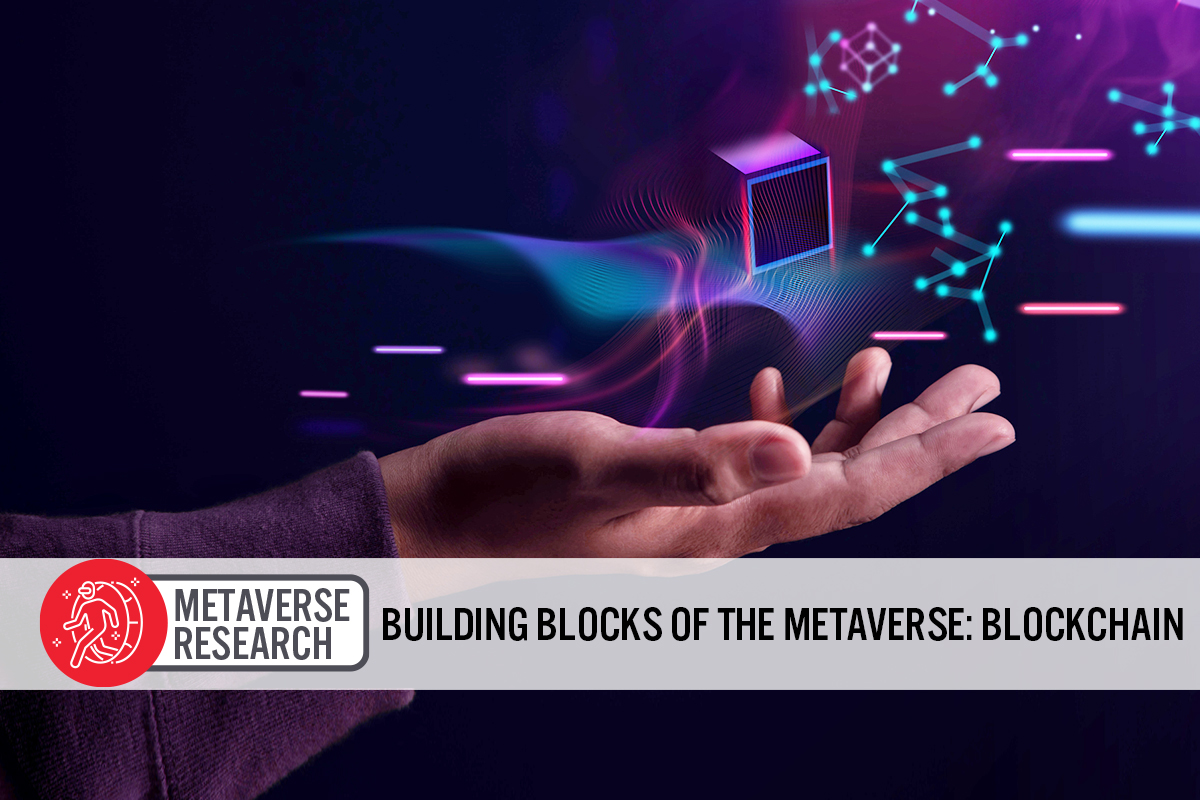
DIpil Das
Introduction
What’s the Story? Coresight Research has identified the emerging metaverse as a key trend to watch in retail and a component trend of Coresight Research’s RESET framework for change. That framework provides retailers with a model for adapting to a new world marked by consumer-centricity, in 2022 and beyond (see the end of this report for more details). The blockchain enables brands and retailers to engage in metaverse commerce and improve product tracking, authentication and overall security for consumers. The blockchain is a system in which a shared record of transactions made in cryptocurrencies is maintained across several computers working together to form a decentralized peer-to-peer network. In this report, we discuss how the blockchain forms the basis of the metaverse, explore the history and technological infrastructure of blockchains, and detail what brands and retailers should know. This report forms part of our Building Blocks of the Metaverse series, which presents insights into the core technological components of the retail metaverse, including important details for retailers to know in establishing a presence and operating in the virtual space. Why It Matters With blockchain technology, there are no third-party transaction costs or delays, and both buyers and sellers can be immediately certain transactions have taken place. Taking power away from centralized institutions and distributing it among the blockchain increases transparency and trust for consumers. Because a record of transactions is stored on every block, control of information is not restricted to a single entity, meaning blockchains are decentralized; a hacker would have to change every single block to corrupt or steal data, a virtually impossible task. In the metaverse, a new decentralized and anonymous universe, people are free to enjoy experiences with limitless possibility without fear of manipulation or privacy breaches. Because of this, the possibilities for self-expression without fear of judgement are virtually endless. As such, commercial opportunities to take advantage of trends that are likely to emerge from self-expression will be plentiful. The metaverse will likely be a synchronous environment, meaning users have instantaneous communication with businesses and brands that, in the real world, could operate thousands of miles away. The blockchain, along with cryptocurrencies, enables seamless cross-border payments not hindered by exchange rates or additional delays from multiple banks involved with transactions. Demonstrating the potential of blockchain, the number of business-to-business (B2B) cross-border blockchain transactions is set to massively increase in the coming years, as show in Figure 1.Figure 1: Global: B2B Cross-Border Blockchain Transactions (Mil.) [caption id="attachment_144796" align="aligncenter" width="700"]
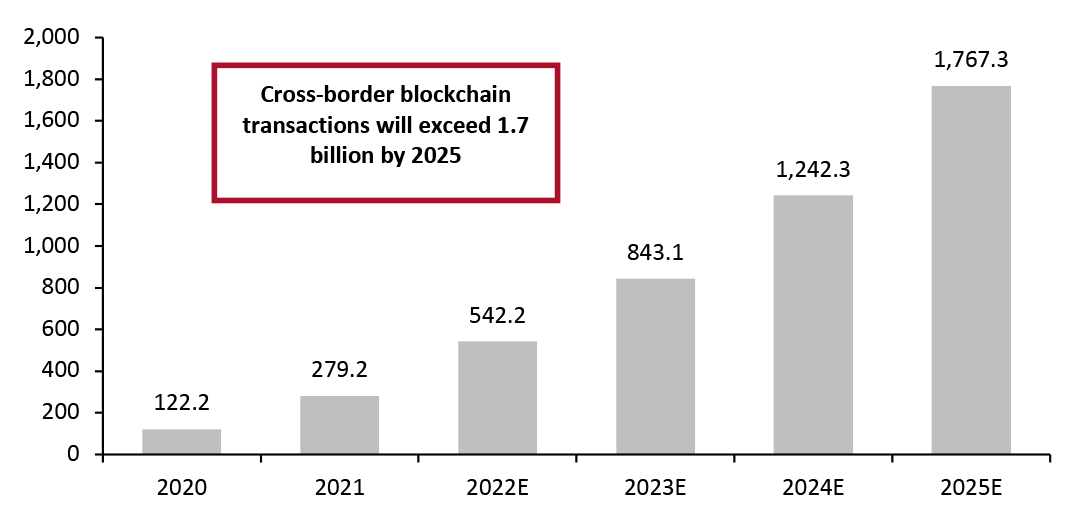 Source: Juniper Research[/caption]
There are many other benefits of the blockchain, including speed, trust, reduced costs, improved privacy, cross-border flow, control and anonymity. Virtual worlds based on the blockchain will enjoy all of these benefits, and as a result, trade between businesses and customers is free to flourish unlike in today’s world of centralized finance, fiat (government) currencies and third parties (banks).
Source: Juniper Research[/caption]
There are many other benefits of the blockchain, including speed, trust, reduced costs, improved privacy, cross-border flow, control and anonymity. Virtual worlds based on the blockchain will enjoy all of these benefits, and as a result, trade between businesses and customers is free to flourish unlike in today’s world of centralized finance, fiat (government) currencies and third parties (banks).
Building Blocks of the Metaverse—Blockchain: Coresight Research Analysis
Advantages of Blockchain in the Metaverse Blockchain provides anonymity in the metaverse, as transactions are only known by wallet addresses. It also allows for economies within virtual worlds to be faster and more efficient in transactions, unlocking active cross-border and high-volume trade. Because transactions are verified by peers and recorded across multiple points in the blockchain, privacy and data security in the metaverse will be superior to current platforms such as social media. Decentralization will help to enable access and improve transparency in virtual worlds, which, by nature, will be difficult to navigate, teeming with avatars, products, worlds and virtual offerings. We explore these advantages in more detail below. Providing Anonymity To Enable Self-Expression Environments constructed on blockchain technology will be completely anonymous—all transactions are tied to wallet addresses, rather than anything linking to a real-world identity. Unless a user wishes others to know their real-world identities, they are free to explore the metaverse and customize their avatars in ways they may not in the real world or on social media due to fear of judgement. Users are free to explore interests with anonymity, engaging with brands globally that they may not shop with in the real world. Blockchain also enables instant payments and transactions between parties that are located far away from one another in the real world. For example, an anonymous user purchased a $450,000 plot of land in The Sandbox’s Snoopverse, Snoop Dogg’s metaverse where he will host concerts and interact with fans. As Snoop Dogg’s brand is heavily influenced by cannabis, the user who purchased this plot may want to remain anonymous for reputational purposes. Plots of land in The Sandbox are represented by NFTs and traded on the Ethereum blockchain. Users may also customize avatars to explore different lifestyles and environments than they would in the real world. For example, history buffs can explore vintage worlds, which simulate various time periods throughout history, and science fiction fans can enjoy alien worlds and virtual space exploration. Without revealing identities, avatars are free to explore different worlds and environments from the comfort of their homes, building interests they never knew they had and exploring immersive offerings accessible to anyone which, in the real world, would be unfeasible to take part in for whatever reason. [caption id="attachment_144797" align="aligncenter" width="700"] Examples of customized avatar looks created by digital avatar company Tafi Avatar
Examples of customized avatar looks created by digital avatar company Tafi Avatar Source: Amazon Web Services [/caption] Decentralization for Protection of Ownership, Transparency and Privacy Blockchain provides users with an immutable record of transactions for history of ownership and creation of assets. No single entity, such as a bank, is responsible for managing ledgers of transactions. Because records are stored on each “block,” or each system, in the blockchain, all blocks would have to be compromised to corrupt data, meaning that ownership of assets is verified and secured. As users become more invested in their digital lives, they will want to protect ownership of virtual assets such as land spaces, apparel, avatars and any unique items they acquire. In virtual environments not built on the blockchain, users may have limited and unique items stolen, with no guarantee of recovery. In a virtual setting, users of all kinds, whether well intentioned or not, will be creating virtual products and reselling products at virtually no cost with no degradation, requesting payment in cryptocurrencies. The transparency that the blockchain provides will help users to navigate the clutter of the metaverse, giving everyone access to product history and data at any time so that they can ensure what they are buying is authentic. One of the biggest issues with social media, currently the most popular use of the “Web 2.0” (non-interactive 2D web) is security. Platforms such as Facebook, Instagram, Twitter and YouTube have access to such large amounts of data, and customers become concerned that their security and privacy is compromised. Because there are multiple worlds, theoretically all interoperable with one another, built on different technologies and blockchain platforms, the metaverse is decentralized; no one entity will have the power to effect large-scale changes or manipulate users by amassing large amounts of data on them. As we mentioned above, transactions are also anonymous, tied only to crypto wallets. Tokenization of Assets NFTs (non-fungible tokens), non-interchangeable units of data transferred on blockchains with smart contract capabilities, could come to represent every type of virtual and digital asset in the metaverse, and even some physical assets in the real world. As such, they will become the backbone of in-world economies, protecting ownership of assets and distinctiveness, and providing interoperability.
- For more information on NFTs and how their underlying technologies will power the metaverse, please refer to our first report in this series, Building Blocks of the Metaverse: NFTs.
Figure 2: Blockchain Layers [caption id="attachment_144807" align="aligncenter" width="700"]
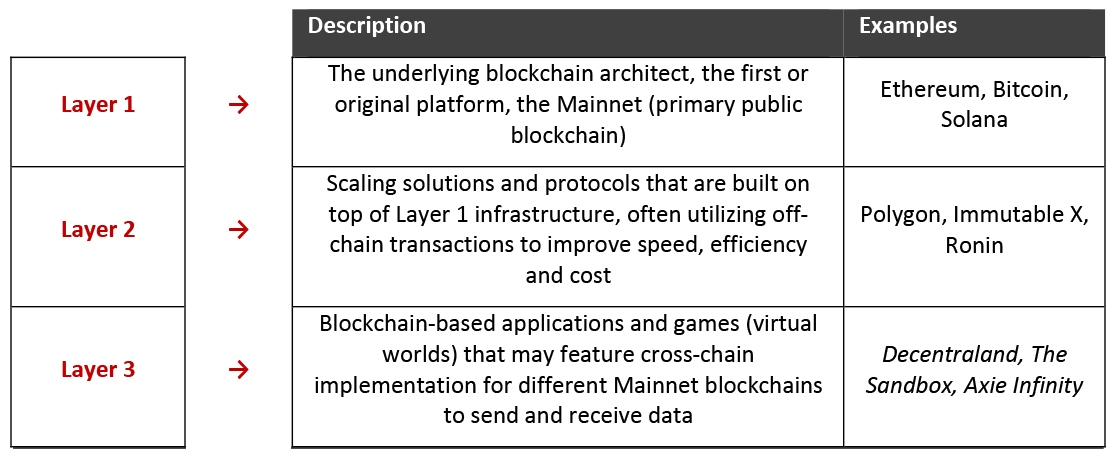 Source: Coresight Research[/caption]
Blocks, Miners and Nodes
Data blocks, which link together in a chain to form the blockchain, can each be thought of as individual pages on a ledger. Blocks are comprised of several components, including the header and the body. Blockchain miners, who can be anyone, download and install special programs on their computers to mine blocks that are added to the chain; these programs also enable their systems to securely communicate with one another. Once a computer installs such a program, it becomes a node in the blockchain.
In simple words, the header is the portion of the block that contains information and data about the block itself, including the following:
Source: Coresight Research[/caption]
Blocks, Miners and Nodes
Data blocks, which link together in a chain to form the blockchain, can each be thought of as individual pages on a ledger. Blocks are comprised of several components, including the header and the body. Blockchain miners, who can be anyone, download and install special programs on their computers to mine blocks that are added to the chain; these programs also enable their systems to securely communicate with one another. Once a computer installs such a program, it becomes a node in the blockchain.
In simple words, the header is the portion of the block that contains information and data about the block itself, including the following:
- Hash—Each subsequently created block contains the hash, or algorithm used for encryption of data, of the previous block.
- Nonce—Miners must calculate a “number only used once” to create a new block and add it to the chain.
- Time stamp—The time stamp contains complete information about date, hours, etc.
- Merkle root—Each transaction on the blockchain comes with a hash, and these hashes are linked in a tree-like structure, called the “Merkle tree.” The Merkle root refers to the base hash that all the transactions are based on (individual hashes are hashed again then merged with one another to create the hash for the entire block).
Figure 3. Client-Server Network vs. Peer-to-Peer (P2P) Network [caption id="attachment_144799" align="aligncenter" width="700"]
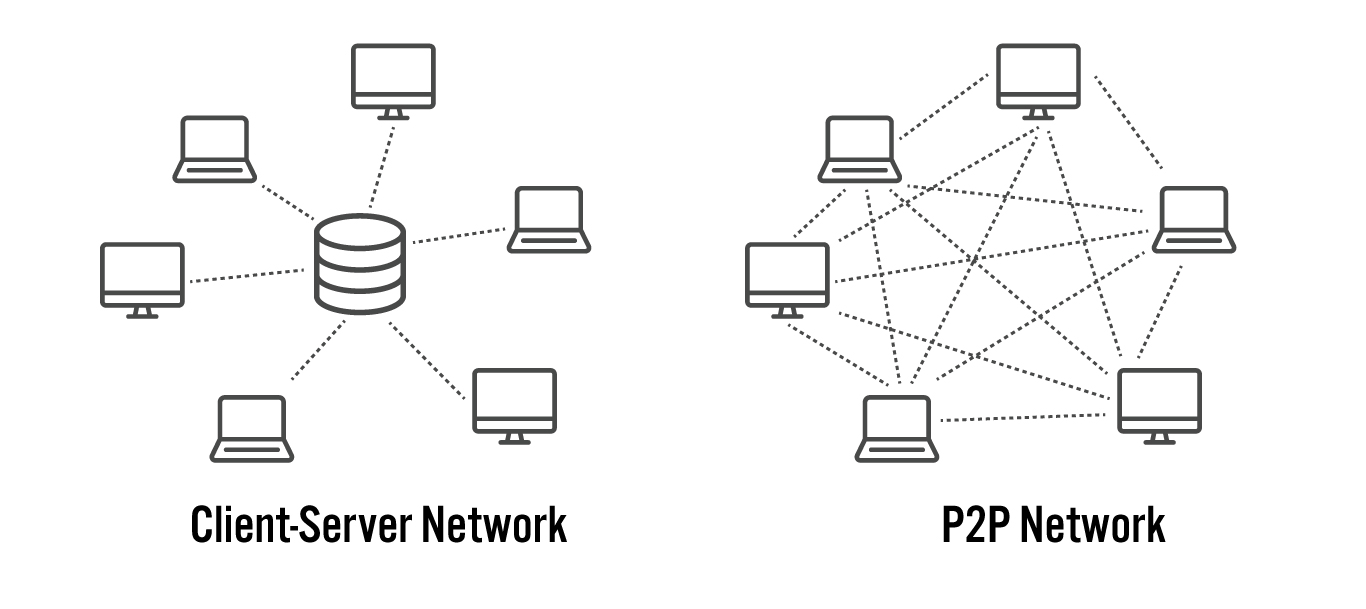 Source: Coresight Research[/caption]
Consensus Mechanisms
Consensus mechanisms, which vary by blockchain platform, are processes used by blockchains to reach agreements on data values in the network; they correlate directly to efficiency and differentiate each blockchain. In other words, these protocols are in place to ensure all nodes are in sync and agree on a transaction, adding it to the blockchain. They are also responsible for increasing security and authenticity of ownership by ensuring each transaction added to the blockchain is legitimate.
Bitcoin, Ethereum and Solana are three of the most popular blockchains; in general, the earlier the blockchain was released, the older and less efficient the mechanism. Each consensus mechanism has its own benefits, but the largest tradeoff seems to be between security and efficiency. In virtual worlds, digital asset trade will likely be higher volume than commerce in the physical world. Depending on what a business may want, many different blockchains could provide solutions.
Source: Coresight Research[/caption]
Consensus Mechanisms
Consensus mechanisms, which vary by blockchain platform, are processes used by blockchains to reach agreements on data values in the network; they correlate directly to efficiency and differentiate each blockchain. In other words, these protocols are in place to ensure all nodes are in sync and agree on a transaction, adding it to the blockchain. They are also responsible for increasing security and authenticity of ownership by ensuring each transaction added to the blockchain is legitimate.
Bitcoin, Ethereum and Solana are three of the most popular blockchains; in general, the earlier the blockchain was released, the older and less efficient the mechanism. Each consensus mechanism has its own benefits, but the largest tradeoff seems to be between security and efficiency. In virtual worlds, digital asset trade will likely be higher volume than commerce in the physical world. Depending on what a business may want, many different blockchains could provide solutions.
Figure 4: Consensus Mechanisms in Popular Blockchains [wpdatatable id=1862 table_view=regular]
Source: Coresight Research Keys and Wallets To transact on the blockchain, users need to set up a cryptocurrency wallet that supports tokens such as Ethereum, Bitcoin and Solana. Examples of wallets include Coinbase Wallet, Exodus and MetaMask. A public key allows users to receive transactions (either NFTs or cryptocurrency transfers). The wallet address is a hashed version of this public key, meaning that users can share it freely. For example, creators may share their address for donations. With the public key, which may or may not be tied to identity (users’ choice), anyone can also see who the owner of an asset or crypto funds is, improving transparency. However, the owner of those assets or funds must have the private key, located in a crypto wallet, to gain access. The private key serves as a password, and can come in many formats, such as a 256-character long code. Regardless of format, the number is massive. Encryption and receiving access is a three-step process:
- A transaction sent to a user is encrypted with the public key, and can only be decrypted with the corresponding private key (the two are created together)
- A digital signature is generated through combining the correct private key with the encrypted data
- Nodes automatically check and authenticate the transaction; any unauthenticated transaction is rejected
- We will cover cryptocurrencies and payments in the metaverse in more detail later in the Building Blocks of the Metaverse series.
- Product quality and supply chain: If an item or product (in the supply chain or after sale to a customer) is found to be defective, blockchain records enable retailers to track the product and see where the fault occurred, then find other defective products. This also helps retailers to highlight weaknesses in supply chains by identifying issues with certain manufacturers or batches.
- Inventory management: Blockchain will allow retailers to have better control over their inventories, improving efficiency to decrease inventory costs and increase customer fulfillment. Assets such as product units and orders can be tokenized and represented on the blockchain, giving retailers the ability to track at every stage. Blockchain tracks vast amounts of data and is a valuable and trustworthy source for forecasting demand.
- Customer loyalty: Customers can be given “loyalty tokens” rather than reward points. Tokens would never expire and could be interoperable on multiple blockchain platforms. This would increase freedom for customers in how they spend their rewards points. Tokens also eliminate the need to develop a costly loyalty system, as the blockchain already contains an immutable history of transactions, a record of loyalty.
- Improved payment channels: Traditional payment providers take far too long to settle transactions. Transactions in the blockchain are as fast as exchanging cash in real life, with no intermediaries to slow the process and charge fees. In centralized finance, as central banks have control to mandate liquidity requirements, they have influence over commercial banks. The blockchain eliminates this centralized control.
- For more on the land-grabbing trend in blockchain-based virtual games, read our separate report, The Virtual Land Grab: Three Key Platforms in the Retail Metaverse.
Figure 5: Popular Virtual Worlds and the Blockchains They Are Constructed On [wpdatatable id=1863 table_view=regular]
Data as of April 1, 2022 Source: CoinMarketCap/DappRadar/Coresight Research, Examples of Retailers Using Blockchain Technologies in Virtual Environments
- Gucci
- Dior
 Dior’s immersive experience via Ready Player Me
Dior’s immersive experience via Ready Player Me Source: Ready Player Me x DIOR [/caption]
What We Think
Blockchain technologies support high-volume digital asset trade, protect ownership and provide authenticity. In a digital sense, where products are easy to create and resell, these features are crucial for functioning in-world economies. The anonymity provided by blockchain allows users to fully express themselves by exploring offerings from brands and retailers operating in different parts of the world and developing new interests. As there are many virtual worlds that will likely all be interoperable, no one entity will have the ability to manipulate users based on data; this is one of the biggest concerns users have of popular Web 2.0 platforms, such as social media. The decentralized nature of blockchains, and the worlds constructed on them, helps to alleviate these concerns. Through a publicly viewable ledger of immutable transactions, transactions and payments are instant and ownership is verified. Such a system is much more powerful than today’s world of centralized finance, where parties must rely on banks to accurately manage transactions, dealing with third-party delays and fees. Blockchains could therefore significantly increase cross-border trade and in-world economic activity. The technology is essential to support the trade volume of in-world economies, as businesses can offer the same experience to consumers from all over the world, expanding their customer bases and enabling access not possible in the real world. For retailers and brands, blockchain offers benefits in product quality and supply chain improvement, inventory management, loyalty programs and payment channels. Although joining blockchain games presents opportunity for brands to significantly expand their customer base, they can enjoy some benefits even without setting up a virtual store or experience on a metaverse platform. Blockchain will empower businesses to conduct seamless transactions with customers from every part of the globe, and as every asset may eventually come to be represented as an NFT traded on the blockchain, it will be crucial for retailers to begin familiarizing themselves with blockchain technology.Appendix: About Coresight Research’s RESET Framework
Coresight Research’s RESET framework for change in retail serves as a call to action for retail companies. The framework aggregates the retail trends that our analysts identify as meaningful for 2022 and beyond, as well as our recommendations to capitalize on those trends, around five areas of evolution. To remain relevant and stand equipped for change, we urge retailers to be Responsive, Engaging, Socially responsible, Expansive and Tech-enabled. Emphasizing the need for consumer-centricity, the consumer sits at the center of this framework, with their preferences, behaviors and choices demanding those changes. RESET was ideated as a means to aggregate more than a dozen of our identified retail trends into a higher-level framework. The framework enhances accessibility, serving as an entry point into the longer list of more specific trends that we think should be front of mind for retail companies as they seek to maintain relevance. Retailers can dive into these trends as they cycle through the RESET framework. The components of RESET serve as a template for approaching adaptation in retail. Companies can consolidate processes such as the identification of opportunities, internal capability reviews, competitor analysis and implementation of new processes and competencies around these RESET segments. Through 2022, our research will assist retailers in understanding the drivers of evolution in retail and managing the resulting processes of adaptation. The RESET framework’s constituent trends will form a pillar of our research and analysis through 2022, with our analysts dedicated to exploring these trends in detail. Readers will see this explainer and the RESET framework identifier on further reports as we continue that coverage.Appendix Figure 1. RESET Framework [caption id="attachment_143517" align="aligncenter" width="700"]
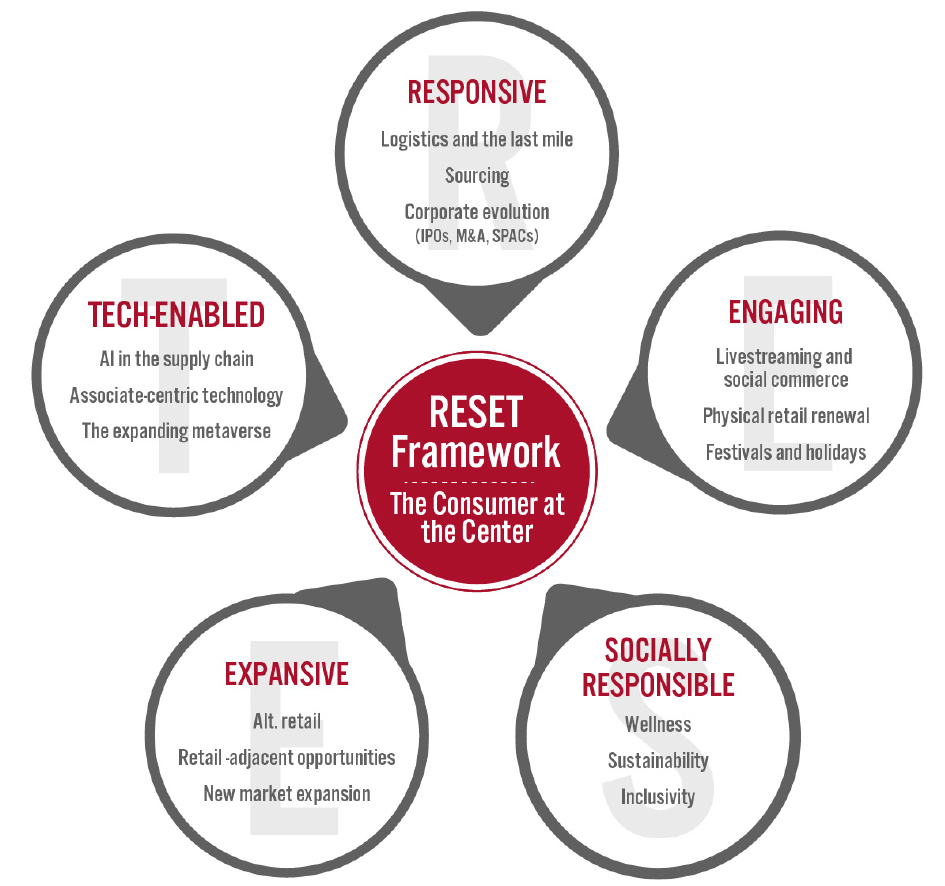 Source: Coresight Research[/caption]
Source: Coresight Research[/caption]